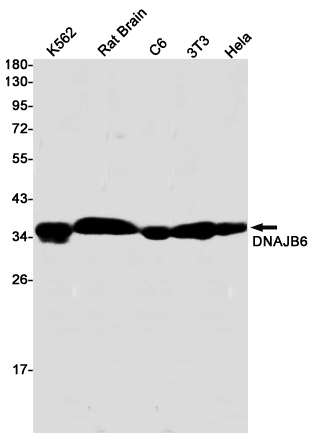DNAJB6 Rabbit mAb
- SPECIFICATION
- CITATIONS
- PROTOCOLS
- BACKGROUND

Application
| WB, IHC-P |
|---|---|
| Primary Accession | O75190 |
| Reactivity | Human, Mouse, Rat |
| Host | Rabbit |
| Clonality | Monoclonal Antibody |
| Calculated MW | 36087 Da |
| Gene ID | 10049 |
|---|---|
| Other Names | DNAJB6 |
| Dilution | WB~~1/500-1/1000 IHC-P~~N/A |
| Format | 50mM Tris-Glycine(pH 7.4), 0.15M NaCl, 40%Glycerol, 0.01% sodium azide and 0.05% BSA. |
| Storage | Store at 4°C short term. Aliquot and store at -20°C long term. Avoid freeze/thaw cycles. |
| Name | DNAJB6 |
|---|---|
| Synonyms | HSJ2, MRJ, MSJ1 |
| Function | Has a stimulatory effect on the ATPase activity of HSP70 in a dose-dependent and time-dependent manner and hence acts as a co- chaperone of HSP70 (PubMed:10954706, PubMed:28233300). Plays an indispensable role in the organization of KRT8/KRT18 filaments (PubMed:10954706). Acts as an endogenous molecular chaperone for neuronal proteins including huntingtin (PubMed:11896048, PubMed:22366786). Suppresses aggregation and toxicity of polyglutamine- containing, aggregation-prone proteins (PubMed:20159555, PubMed:22366786). Also reduces cellular toxicity and caspase-3 activity (PubMed:11896048). |
| Cellular Location | Cytoplasm, perinuclear region. Nucleus Cytoplasm, myofibril, sarcomere, Z line |
| Tissue Location | Widely expressed. Highest levels in testis and brain, and lower levels in heart, spleen, intestine, ovary, placenta, lung, kidney, pancreas, thymus, prostate, skeletal muscle, liver and leukocytes. In testis, expressed in germ cells in the earlier stages of differentiation pathway as well as in spermatids. In brain, expressed at a higher level in hippocampus and thalamus and a lower level in amygdala, substantia nigra, corpus callosum and caudate nucleus |

Thousands of laboratories across the world have published research that depended on the performance of antibodies from Abcepta to advance their research. Check out links to articles that cite our products in major peer-reviewed journals, organized by research category.
info@abcepta.com, and receive a free "I Love Antibodies" mug.
Provided below are standard protocols that you may find useful for product applications.
If you have used an Abcepta product and would like to share how it has performed, please click on the "Submit Review" button and provide the requested information. Our staff will examine and post your review and contact you if needed.
If you have any additional inquiries please email technical services at tech@abcepta.com.













 Foundational characteristics of cancer include proliferation, angiogenesis, migration, evasion of apoptosis, and cellular immortality. Find key markers for these cellular processes and antibodies to detect them.
Foundational characteristics of cancer include proliferation, angiogenesis, migration, evasion of apoptosis, and cellular immortality. Find key markers for these cellular processes and antibodies to detect them. The SUMOplot™ Analysis Program predicts and scores sumoylation sites in your protein. SUMOylation is a post-translational modification involved in various cellular processes, such as nuclear-cytosolic transport, transcriptional regulation, apoptosis, protein stability, response to stress, and progression through the cell cycle.
The SUMOplot™ Analysis Program predicts and scores sumoylation sites in your protein. SUMOylation is a post-translational modification involved in various cellular processes, such as nuclear-cytosolic transport, transcriptional regulation, apoptosis, protein stability, response to stress, and progression through the cell cycle. The Autophagy Receptor Motif Plotter predicts and scores autophagy receptor binding sites in your protein. Identifying proteins connected to this pathway is critical to understanding the role of autophagy in physiological as well as pathological processes such as development, differentiation, neurodegenerative diseases, stress, infection, and cancer.
The Autophagy Receptor Motif Plotter predicts and scores autophagy receptor binding sites in your protein. Identifying proteins connected to this pathway is critical to understanding the role of autophagy in physiological as well as pathological processes such as development, differentiation, neurodegenerative diseases, stress, infection, and cancer.



